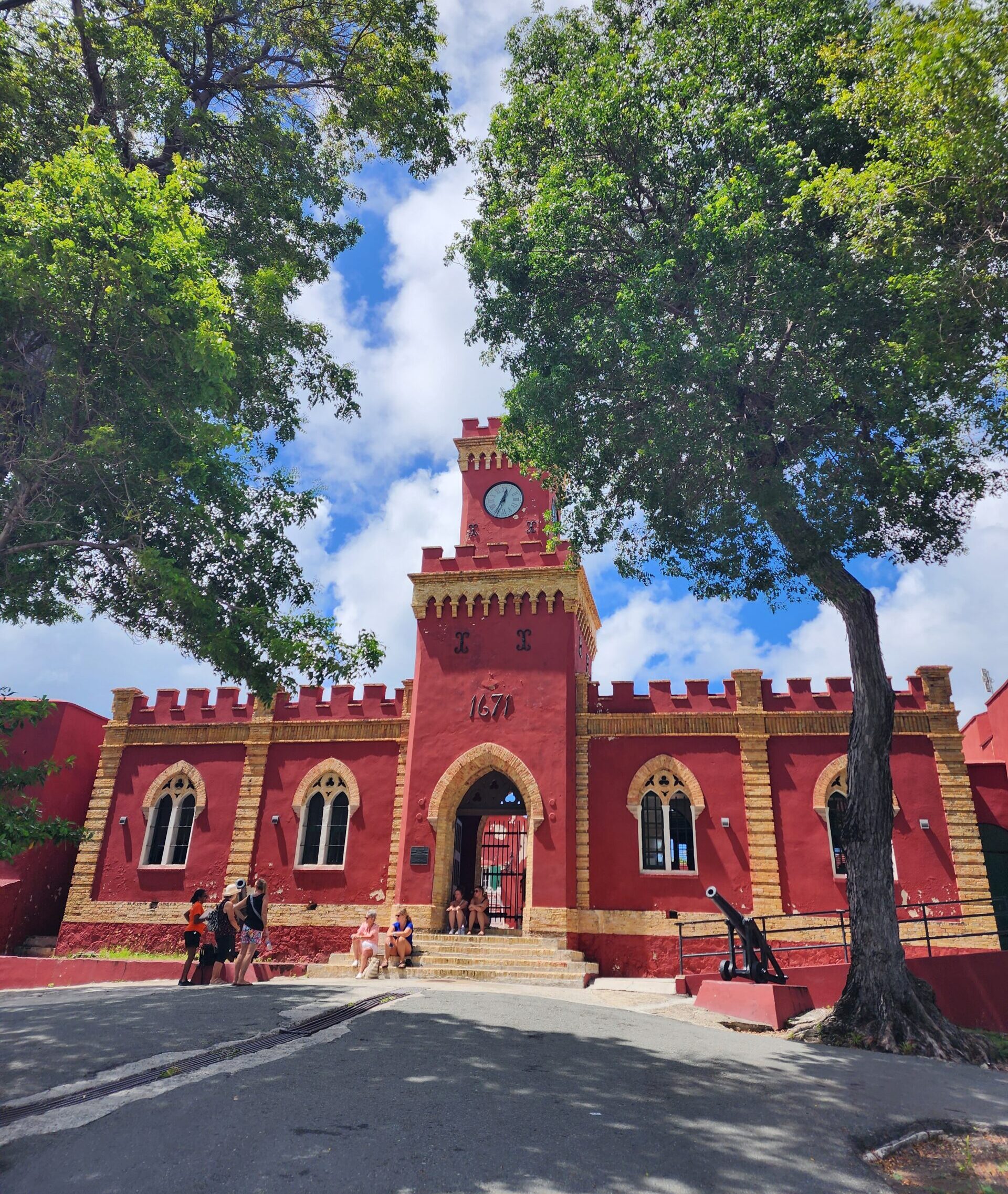Historic Military Fort Christian in St. Thomas, Virgin Islands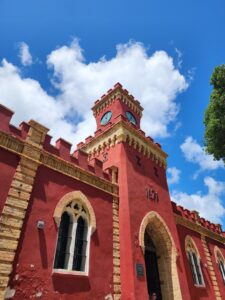
(If you aren’t interested in reading about some history, you can skip to the last section with visitor information.)
The oldest and most formidable structure in St. Thomas is, without a doubt, Fort Christian. Named after the Danish King Christian V who first authorized the colony in St. Thomas, it is also one of the oldest buildings in the United States.
This red monstrosity sits just across the street from Charlotte Amalie Harbour – the fortress-like walls imposing themselves upon the downtown landscape.
Early History of The Fort
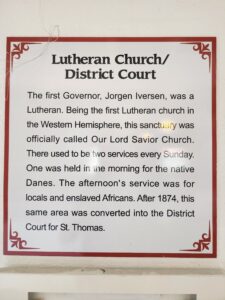
Right around the 1670s the Danish definitively staked their claim to St. Thomas by breaking ground on the fort. Starting a new colony is no easy feat. Aside from storms, starvation and disease, the early settlers were also aware of the danger of invaders, pirates and privateers. So the first settlers made the fort’s construction one of its highest priorities.
Just about every able bodied person assisted in the building project. Of special note is the man Simon Lamar. Who was Simon Lamar you ask? Simon was a skilled craftsman. He, along with the governor, were most instrumental in the fort’s design and construction. Of special note for those keeping count, Simon was a mulatto. He came over to St. Thomas as an indentured servant from St. Eustatius. I wish we knew more about this guy. Not sure if at the time this was a big deal – but it seems pretty cool that a mixed-race dude was largely responsible for the massive island project.
After Simon worked off his indenture, he was freed, bought a plantation, bought a slave, got married (to the lovely Ebbonetie Bokollj), had a family and was a member of either the Lutheran or Reformed Church. (The guy kinda reminds me of me although my indenture was only 3 years and I never owned a slave and I’m not that crafty and I’m white as far as I know.)
And the construction couldn’t have started soon enough for the tiny settlement. On February 2, 1678, only about 6 years after landing on the island, the French attacked St. Thomas. But the Danes, with a small armed force and the nearly complete fort, were able to repulse the French with a middle finger raised high. I bet there was one heck of a party that night.
(Cool note: 400-years-ago they had regional and world wars all the time. Right around the time St. Thomas was established, Denmark and Norway and a bunch of other countries were involved in all sorts of wars – Scanian War, Franco-Dutch and others that all seem to blend together. And the continuously shifting alliances are dizzying. Anyhow, those wars often spread to the Caribbean. And based on some conflict, the French felt justified in attacking the Danish colony. So 60 French soldiers/settlers from St. Croix attempted an invasion on St. Thomas. They were easily beat back but apparently did make off with a few slaves.)
With that encounter, the Danes proved they were nobody’s kid sister. By 1680, the fort was complete and St. Thomas was ready for prime time.
Fort Christian Uses
The fort served many purposes over the centuries. During Danish rule, Lutheranism was the royally approved denomination of the King and his subjects. And until much later, the Lutheran church was housed inside the walls of the fort. Also, most of the seats of government, military and judiciary were housed in Fort Christian. And even into the 20th century prisoners were housed in the fort.
Check out this dungeon room for solitary confinement:
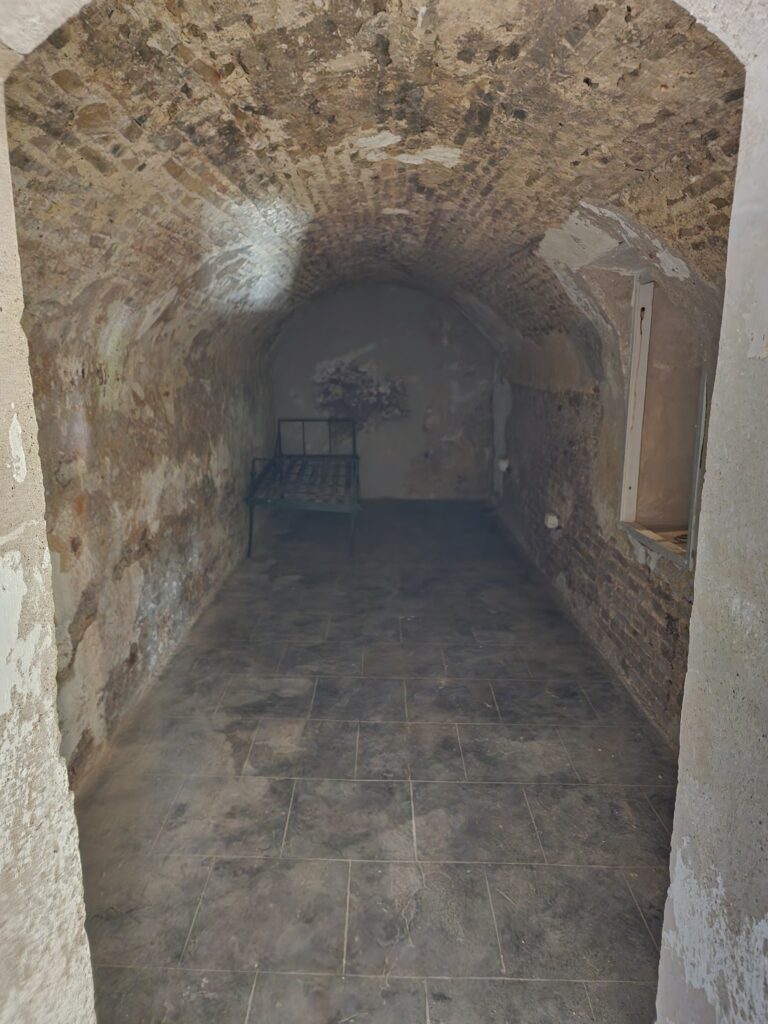
I think the fun part of history is that we can observe atrocities and death with a bit of levity. Time heals all wounds. And as we know, history is filled with injustices, twists of fate, murders and all sorts of mayhem. St. Thomas’ history is no exception. Hangings and judicially-ordered punishments were meted out at the fort. They flogged people for all sorts of infractions. Hangings were reserved for more serious crimes (usually).
A fun little fact: It was required that a slave, owned directly by the King of Denmark, assisted in all beatings and hangings. And if the main executioner or punisher was unavailable, the King’s slave would carry out the judgment. I’m guessing that dude didn’t hate his job too much.
All the fun aside, the fort’s main purpose was to defend the growing town of Charlotte Amalie. And to that effect, the 3-4 foot thick walls are made of brick and stone. Once upon a time, there was a 3-story tower keep inside the fort. The keep was loaded with munitions for one last stand should the outer walls fall to an invader.
Before an enemy could hope to reach the walls, they had to navigate one of the ultimate defenses known to man: cactus. The Danish had cultivated the native prickly pear cactus and planted thick rows of them at the base of the fort. The pointy barrier was nearly impenetrable.
All boats entering Charlotte Amalie harbour were hailed by the fort. If they did not respond and send in a boat, the fort would start firing live cannon rounds over the boat until they complied. Also, no foreign vessel was allowed to leave the harbour after sunset. If attempted, 2 warning shots blasted from the fort’s guns. If the boat remained quiet, the battery would unleash all required missiles to end the indiscretion. So the fort was an imposing deterrent when necessary. (Although when the governor was welcoming some of his pirate buddies, the rules were relaxed.)
For the most part, the fort was able to repel enemies and rapid attacks. But for as formidable as it may seem, Fort Christian was not strong enough to ward off a force of any significance – as the British were happy to prove on a couple of occasions.
Famous (and infamous) Prisoners and Visitors
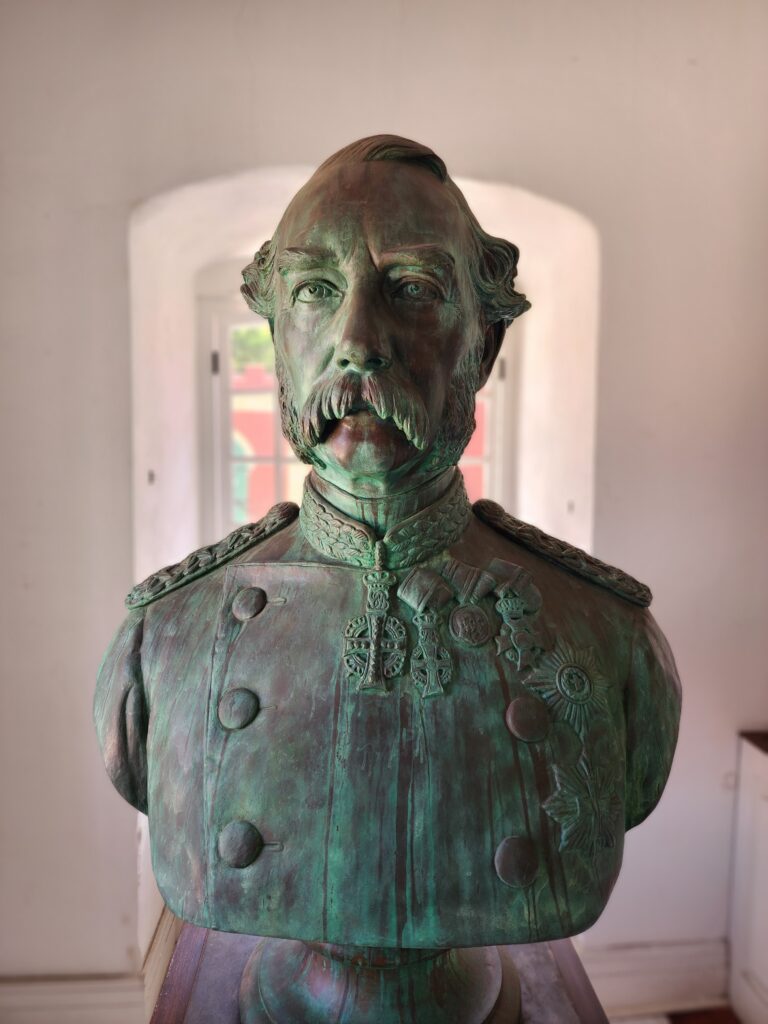
Governor Peter von Scholten
Governor Peter von Scholten was a big deal. He was pivotal in the emancipation of the slaves. Against the very King of Denmark he boldly announced that all slaves were free. He rode his carriage out to the gathering mass of slaves, got out of his carriage and made the announcement. There is speculation he colluded with leading slaves to demonstrate and threaten rebellion. He denied it of course, but it does seem very possible. Either way, he had some brass balls to stand so close to the rebels.
John Gottlieb, aka “General Buddoe”
In 1848 there was a slave rebellion that ultimately led to the emancipation of all enslaved people in the Virgin Islands. One of the leaders was General Buddoe. The guy was a badass riding around on a horse with a sword leading the slaves to freedom.
Even though he did much to quell and pacify the newly free laborers, General Buddoe as arrested, imprisoned, and later deported to Trinidad. He is said to have made his way to New York City by 1850.
David Hamilton Jackson
Even though he as born after slavery had been abolished, freed slaves’ weren’t exactly living the good life. Jobs and pay was scant. David Hamilton Jackson, became an activist for the workers on St. Thomas and St. Croix. His outspoken approach wasn’t embraced by the crown’s representatives. He often squared off against the authorities at Fort Christian.
Alexander Hamilton
The young Alexander Hamilton was a clerk for an import-export firm in St. Croix. His dealings with boats, captains, trade, customs, planters and all manner of island commerce often brought him to St. Thomas and Fort Christian.
Camille Pissaro
The French Impressionist painter lived most of his youth in St. Thomas. His home was just a 2-3 minute walk from the fort. Doubtless he walked the grounds of this historic building. While probably lost to history, I’m going to guess that at some point he must have sketched or at least doodled a picture of the fort. You can put me down for $1000 on that bet.
Danish Royal Visits
The Danish royalty weren’t exactly beating down the doors to visit St. Thomas. But over the years, many passed through the walls of the fort. Most notable:
May 28, 1976 – Queen Margarethe II visited many of the landmarks of St. Thomas
November 22, 1879 – Prince Valemar, son of King Christian IX dropped by for a visit
Last Section: Visiting Fort Christian in St. Thomas
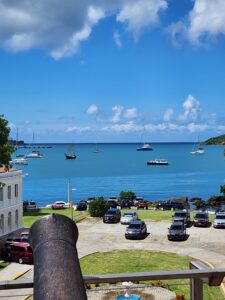
Fort Christian is located in Charlotte Amalie in St. Thomas. It is hard to miss – a massive reddish military-lookin thing. If you are interested in touring the fort and also the rest of town on a guided tour, check out Blue Mango Tours that does unique walking tours with a tour of the fort.
If you are driving you can park right next door in the Fort Christian Parking Lot. They charge $2/hour.
If you are visiting on a cruise grab a taxi at the ship ask them to drop you at the front of the fort. It’s a 5-6 minute taxi ride from the cruise port. The fort is almost always open weekdays during business hours.
Currently there is a $10 admission fee for entry.
Once inside you will have nearly unfettered access. There are two sections roped off since there are antique furnishings and items dating back hundreds of years. So you’ll still be able to observe the rooms but from behind a rope. Otherwise, you can explore most of the fort.
For amazing views of town and the harbour, head up to the terreplein. This is where soldiers surveyed the harbour for pirates and enemies. It’s also where the cannons were readied for a salute or battle.
In its heyday, Fort Christian boasted 36 guns. Not too shabby for a tiny little island.
Here’s something cool to imagine: Stand on the terreplein or parapet. Look down to the left at the parking lot. All that was water with a little strip of land. On that little strip was a generous cannon battery bristling for a fight. The area was backfilled in the 1900s and by mid-century was a parking lot.
Other notable sites to explore in the fort are the dungeon, cook house, courthouse and governor’s living quarters (the previously mentioned roped-off section).
If you have a keen eye for details, wherever you see wood in the architecture, it’s from local mahogany trees. The island used to be full of the majestic mahogany. The wood is an incredibly dense and strong wood resistant to rot and termites. It is also now endangered and protected in the Virgin Islands. You’ll see some wonderful specimens right in front of the fort.
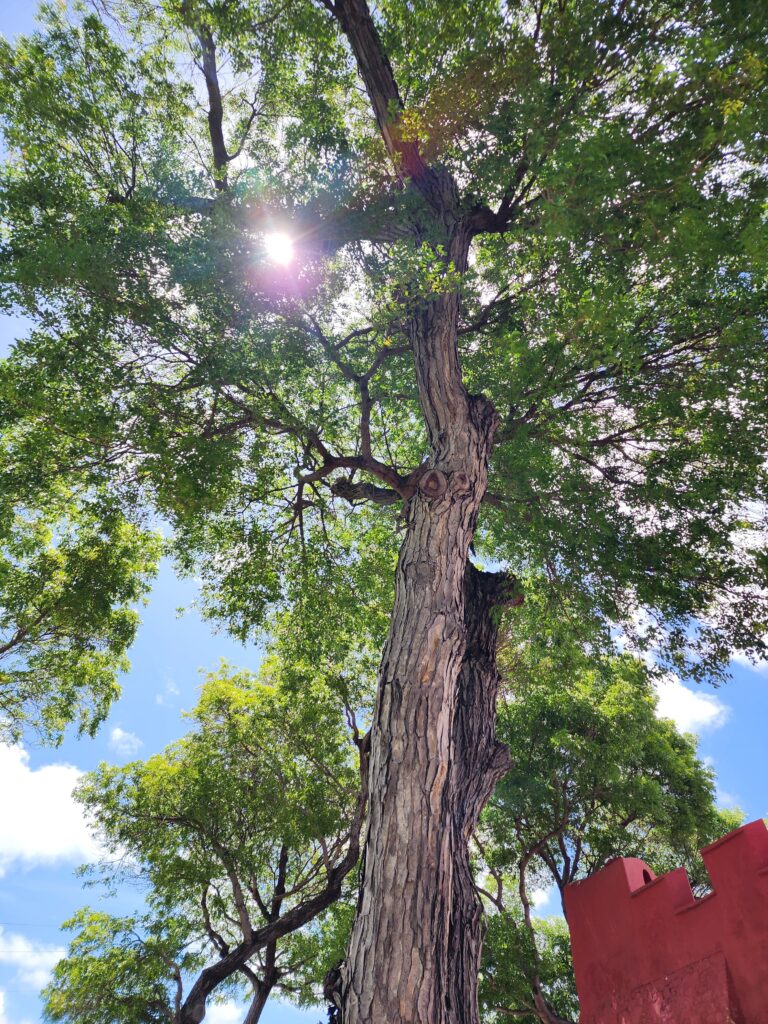
It is well worth the $10 to spend 30 minutes or more exploring the halls, walls and dungeon of this place. There aren’t a ton of exhibits to see but you can feel the history here. Some of the rooms feel like they could have recently housed a Danish soldier or unruly slave. When deep within the walls the air is heavy and undoubtedly carries the weight of three centuries of history.
